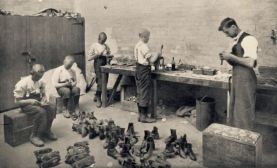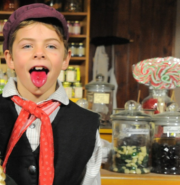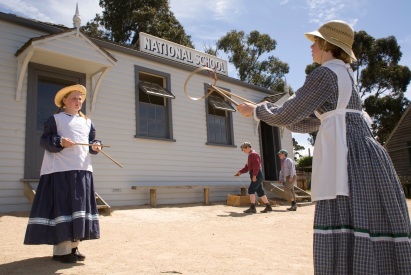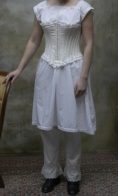Growing up on the Victorian goldfields was tough, even for children from rich families. If you had healthy parents, you could expect to have lots of brothers and sisters, and if they couldn’t afford to send you to school, you would be sent to work instead. Girls and boys experienced childhood quite differently back then, and if you had one or even two toys, you were a lucky child indeed!

- Ballarat Orphanage boot factory, date unknown. Reproduced with permission of the Gold Museum.
Life on the goldfields was dangerous for children. While falling down a mineshaft or being trodden-on by a horse was always a risk, the big killer of children was disease. In the 1850s, people – especially children – often died from diseases which rarely kill Australians today, like scarlet fever, pneumonia, diphtheria and consumption (tuberculosis). However, children were most likely to die from drinking water contaminated by human ‘poo’ … Horrible diseases like dysentery, cholera and typhoid killed thousands of children during the Victorian gold rushes. Until Germ Theory was developed and the flushing toilet introduced, such ‘poopy’ diseases could kill as many as HALF of all British children before the age of five! Parents sometimes died of diseases and accidents too, and life was especially tough for the orphans of the gold rushes. Fortunately, we had kind people (philanthropists) in Ballarat like Emanuel Steinfeld, who established a free school for local orphans during the gold rushes.
19th century goldrush families tended to be larger than Australian families today; having lots of children ensured that some survived to old age and were therefore able to look after their elderly parents (there was no pension to support senior citizens back then). Another reason for large families was tradition. Before the Industrial Revolution (c.1750-1900), most Europeans lived and worked on farms, and having lots of children meant that you had extra hands to help look after the animals and grow the food. That’s why many children worked in England’s factories at the beginning of the Industrial Revolution. It was absolutely normal for children to work and contribute to the household income. So, when Europeans moved to Victoria in their tens-of-thousands during the gold rushes, many brought this idea of working children with them. Young boys often worked in mines or as assistants to labourers and shopkeepers, while young girls would train as maids or seamstresses (women who sew clothes) but would only work until they were married (because after that they were expected to be full-time mothers and housewives).

Lollies – like our famous raspberry drops – were adult treats in the 19th century!
Eventually, people decided that childhood was a special time in a person’s life and should be dedicated to learning and play, which meant that sending a child to work became illegal. Nowadays, children in Victoria can’t legally work until they are 13 years old, and can only work then if they have a special ‘Child Employment Permit’ from the State Government. If you are 15 years or older, you are free to work without a permit.
Believe it or not, there was no free schooling in Victoria until the 1870s. So, if your family arrived in Ballarat in the 1850s, you would only be sent to school if your parents could afford the tuition costs. This meant that lots of poor children didn’t learn to read and write, and girls were often kept at home to learn the ‘art’ of housekeeping while their brothers received an education. If girls were sent to school, they often learnt different skills to the boys (they might learn cross-stitch while the boys learnt technical drawing). The girls were also encouraged to play different games to the boys during the breaks between lessons. ‘Graces’, for example, was a game specifically for girls. During the 1850s and 60s, it is thought that only half of Victoria’s children were lucky enough to get an education (Bradby, D. and Littlejohn, M., Life in Colonial Australia, Walker Books Australia, 2015, p.17).

Girls playing a gentle, ‘feminine’ game of Graces in the Sovereign Hill Costumed Schools Program.

Women’s underwear in the 19th century: a corset, chemise and pantalettes.
Boys and girls wore very different clothes during the gold rushes, but only after a boy was ‘breeched’. Both boys and girls wore dresses until boys were toilet-trained and considered ‘ready’ for pants (in those days, boys’ pants were called knickerbockers). This ‘breeching’ often involved a little party to celebrate this rite-of-passage for young boys. Girls wore short dresses and smocks over their pantalettes (loooong white underpants) until the age of 12-14 when they would begin wearing women’s clothes like crinolines, corsets and long dresses. Not long after this, they would start looking for a husband … Young women usually married quite young in comparison to now, while young men waited until they had a good job and enough money to support a wife and children. Those who had been academic high-achievers at school could become teachers from as young as 14 years of age!
Being an Aboriginal young person would have been very difficult at this time also; by the 1850s, thousands of Victorian Aboriginal people had been forced off their ancestral lands by European sheep farmers and gold miners. Many Aboriginal people across Australia found it very difficult to practise traditional culture, and pass on their knowledge, skills and stories to the next generation thanks to the European colonisation of this continent.
So, if you could be born in another historical period, would you choose the 19th century? Why/why not?
Links and References
The history of child labour: https://en.wikipedia.org/wiki/Child_labour
Industrial Revolution English children – in their own words: https://www.youtube.com/watch?v=87eVOpbcoVo
The history of the concept of childhood video: https://www.youtube.com/watch?v=3MqMuqJpVyM
The history of the concept of childhood on Wikipedia: https://en.wikipedia.org/wiki/Childhood#History
Children on the goldfields: http://www.resourcesandenergy.nsw.gov.au/__data/assets/pdf_file/0019/109324/children-on-the-goldfields.pdf
More information about children on the goldfields: http://ergo.slv.vic.gov.au/explore-history/golden-victoria/life-fields/children
School in the 1850s: http://www.myplace.edu.au/decades_timeline/1850/decade_landing_15_1.html?tabRank=3&subTabRank=2
Children’s fashion in the 1850s: https://sovereignhilledblog.com/2012/11/26/gold-rush-babes-childrens-fashion-in-the-1850s/
Women’s work in the 19th century: http://www.bbc.co.uk/history/british/victorians/womens_work_01.shtml
Bradby, D. and Littlejohn, M., Life in Colonial Australia, Walker Books Australia, 2015.
Deary, T., Horrible Histories: Vile Victorians, Scholastic Children’s Books, London, 1994.








